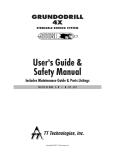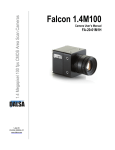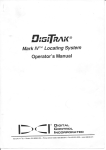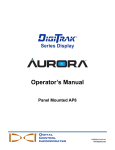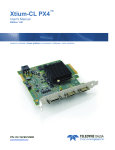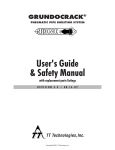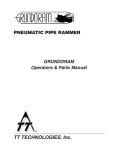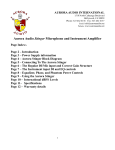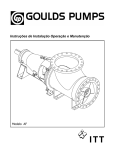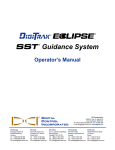Download Grundosteer Manual - TT Technologies, Inc.
Transcript
STEERABLE UNDERGROUND BORING TOOL GRUNDOSTEER Operators & Parts Manual ® TT TECHNOLOGIES, Inc. Table of Contents Safety Section Safety Information about the GRUNDOSTEER . . . . .4-7 Operations 1. 2. 3. General Information . . . . . . . . . . . . . . . . . . . . . . . . . . . . . .8 Applications . . . . . . . . . . . . . . . . . . . . . . . . . . . . . . . . . . . . .9 Technical Specifications . . . . . . . . . . . . . . . . . . . . . . . . . .9 Tool Length . . . . . . . . . . . . . . . . . . . . . . . . . . . . . . . . . . . . . . . . . . . .9 Tool Weight . . . . . . . . . . . . . . . . . . . . . . . . . . . . . . . . . . . . . . . . . . . .9 Tool Diameter . . . . . . . . . . . . . . . . . . . . . . . . . . . . . . . . . . . . . . . . . .9 Compressor Requirements . . . . . . . . . . . . . . . . . . . . . . . . . . . . . . . .9 Hose Length & Construction . . . . . . . . . . . . . . . . . . . . . . . . . . . . . . .9 Tool Heads . . . . . . . . . . . . . . . . . . . . . . . . . . . . . . . . . . . . . . . . . . . .9 Sonde Specifications . . . . . . . . . . . . . . . . . . . . . . . . . . . . . . . . . . . . .9 Receiver & Remote . . . . . . . . . . . . . . . . . . . . . . . . . . . . . . . . . . . . . .9 Control Unit . . . . . . . . . . . . . . . . . . . . . . . . . . . . . . . . . . . . . . . . . . . .9 Lubricator . . . . . . . . . . . . . . . . . . . . . . . . . . . . . . . . . . . . . . . . . . . . .9 4. Set Up . . . . . . . . . . . . . . . . . . . . . . . . . . . . . . . . . . . . . . . . . .9 Launch & Exit Pits . . . . . . . . . . . . . . . . . . . . . . . . . . . . . . . . . . . . . . .9 Head Assembly . . . . . . . . . . . . . . . . . . . . . . . . . . . . . . . . . . . . . . .10 Tool Calibration . . . . . . . . . . . . . . . . . . . . . . . . . . . . . . . . . . . . . . . .12 System Set Up . . . . . . . . . . . . . . . . . . . . . . . . . . . . . . . . . . . . . . . .12 2 TT TECHNOLOGIES, INC. 5. Operation . . . . . . . . . . . . . . . . . . . . . . . . . . . . . . . . . . . . . . .15 Alignment . . . . . . . . . . . . . . . . . . . . . . . . . . . . . . . . . . . . . . . . . . . .15 Tracking . . . . . . . . . . . . . . . . . . . . . . . . . . . . . . . . . . . . . . . . . . . . .15 Steering . . . . . . . . . . . . . . . . . . . . . . . . . . . . . . . . . . . . . . . . . . . . .15 Soil Conditions . . . . . . . . . . . . . . . . . . . . . . . . . . . . . . . . . . . . . . . .16 Horizontal Straight Bore, No Slope . . . . . . . . . . . . . . . . . . . . . . . . .16 Right Bend 3 o'clock Bore . . . . . . . . . . . . . . . . . . . . . . . . . . . . . . . .18 Gradient Change, Hill Bore . . . . . . . . . . . . . . . . . . . . . . . . . . . . . . .19 6. 7. 8. 9. Attachments/Accessories Maintenance . . . . . . . . . . . . Troubleshooting . . . . . . . . . Replacement Parts . . . . . . . . . . . . . . . . . . . . . . . . . . . . . . . . . . . . . . . . . . . . . . . . . . . . . . . . . . . . . . . . . . . . . . . . . . . . . . . . . . . . . . . . . . . . . . . . . . .20 .21 .21 .22 TT TECHNOLOGIES, INC. 3 Important Safety Instructions 1. This symbol calls attention to important safety instructions which, if not followed, could result in serious personal injury or death. Read, understand and observe all safety information and instructions in this manual, and on safety decals on the GRUNDOSTEER piercing tool before using it. For safety reasons, read the operators manual carefully and exercise caution while using the GRUNDOSTEER piercing tool. Please note specific safety requirements as explained by procedures called out in this manual. Failure to follow these instructions could result in serious personal injury or death. All tools, materials and equipment manufactured and supplied by TT Technologies, Inc. are designed to be used by qualified and trained personnel only. TT Technologies, Inc. will not be held liable for any injury or damage to either people or property resulting from the misuse of TT Technologies equipment. Please save this user's guide for future reference and have it available to all operating personnel. Personnel should thoroughly read this operating manual. READ MANUAL FIRST WEAR SAFETY GLASSES WEAR SAFETY SHOES WEAR SAFETY GLOVES CAUTION: When working with compressed air, follow necessary precautions to avoid injury. WARNING: Before you dig, contact the local utilities to determine the location of all area service lines. DANGER: Contact with electrical lines may result in death or injury. The user should be properly trained in correct procedures for work around electrical lines. SAVE THESE INSTRUCTIONS 4 WEAR HARD HAT TT TECHNOLOGIES, INC. Follow all safety instructions concerning safety and possible danger. Do not modify or remove the safety devices or warning labels of this machine. Keep all labels regarding safety and possible danger on the machine in good, readable condition. Special care is required before and during the safety check. Every crewmember should fully understand the safety measures required for the operation and should be capable of following these regulations individually. GRUNDOSTEER is manufactured to the current technical safety-relevant regulations. Nevertheless, the use of the machine may represent a danger to the health and life of users or third parties. Always ensure that you pay particular attention to warnings, safety labels and instructions. Read Operators Manual Before starting the machine, fulfill all safety related requirements. All personnel should thoroughly read this operating manual. Follow all safety instructions concerning safety and possible danger. Do not modify or remove the safety devices or warning labels of this machine. Keep all labels regarding safety and possible danger on the machine in good, readable condition. Special care is required before and during the safety check. Every crew member should fully understand the safety measures required for the operation and should be capable of following these regulations individually. Call Before You Dig Check the existence and exact position of buried pipe and cables by contacting the respective utilities or owners of networks. The exact and definite existence and position of buried cables and pipes should be defined by trial pits or using cable and pipe detection equipment or other means. Cable Strike Should you accidentally hit an electrical cable, immediately leave the site, ensure no one enters and contact the electrical company to turn off the supply. DO NOT touch the hose couplings or the control box. Be aware of the potential for current to be running through the hose. In case of a cablestrike, the danger resulting from that damaged electric cable can only be evaluated following detailed information by the respective electrical company. Never rely on your own knowledge as to types of cables, safety measures and protective measures that may not be correct for the type of cable encountered. Always consider cables to be “live” and a potential danger to life. Do not re-enter the site until authorized by the electrical company. Danger of Entrapment Do not place hand in moving machine components or devices. Always ensure that all safety guards, covers or other safety devices are correctly in place “before starting.” Do not remove safety covers or safety devices during operation of the machine. No loose clothes Do not wear loose clothes or long hair. Danger of body injury by loose clothes or hair being caught in the moving parts of the machine. SAVE THESE INSTRUCTIONS TT TECHNOLOGIES, INC. 5 Do Not Over-Pressurize Do not over pressurize, otherwise explosion or serious damage may occur. Do not exceed the operating pressure of 100 psi (7 bar). Make sure to only use original T.T. hoses with T.T. couplings that are suitable for this pressure. Suspended loads Do not stand under suspended (floating) loads. Danger of body injury by falling loads. Use suitable means of avoiding danger. Safety Equipment The operating crew should always wear the appropriate safety equipment, i.e., safety shoes/boots, hard hat, safety glasses, gloves, ear protection etc. Safety mats should also be used to protect from electrical shock. Operation by Qualified Personnel Only Operation of the GRUNDOSTEER should be carried out by suitably trained, qualified, and certified personnel only. New operators or operators in training should be working under the constant supervision of a qualified person. Personnel operating the GRUNDOSTEER should have sufficiently studied the operating manual. Disconnecting Air Hoses Only disconnect pressure free hoses. Always turn off the compressor and bleed all air before disconnecting hoses. Before starting any maintenance or inspection work, ensure that the GRUNDOSTEER is not connected to any air supply. During repair and maintenance operations always follow the respective safety recommendations. Repair and maintenance operations are restricted to trained and certified staff only. Skin Burning Warning This item can be hot or cold. Do not touch as burns may result. Air Hose and GRUNDOSTEER Tool Maintenance Never use self-swaged hoses. Swaging, re-fitting or replacement of air hoses should always be done in a specialist workshop only. Make sure that the hose couplings are properly tightened before starting the compressor. Check all hoses, pipe lines, fittings, joints and securing bolts daily for correct position and function before starting the bore. Use the machine only if it is in perfect working order and after studying the operating manual, particularly the safety-related sections. Always check the machine and its accessories for unwanted movements. To guarantee long life, regular maintenance is essential. Inadequate or infrequent repair and maintenance operations may lead to accidents, downtime and costly repairs of the machine. Transporting the GRUNDOSTEER Tool Danger of accidents. The downward movement of the piston may lead to the GRUNDOSTEER slipping through the textile sling or through the operator’s hand. Never lift or carry the machine using the air hose-damage to the hose may result. Handling and transporting the machine should be done on a flat, level surface only. Do not overload the transportation vehicle. SAVE THESE INSTRUCTIONS 6 TT TECHNOLOGIES, INC. Using a Starting Cradle & Entrance & Exit Pit Excavation It is recommended that the GRUNDOSTEER be used with the starting cradle for correct alignment. Do not touch the steel cable. Do not re-tension during operation. In case of boring above or below known utilities (electrical, gas, water, telecom or others) make sure that a starting cradle is used to align the machine onto the target point. Secure the starting cradle so that the front is the length of the GRUNDOSTEER head assembly away from the front wall. The walls of the starting pit should be made vertical where the machine enters. If the soil in the starting pit is very soft and loose, then the cradle should be supported on wooden boards, fixed timber or other means. Always ensure that no buried services are beneath the starting cradle in the launch pit otherwise you may drive an earth anchor into them and cause serious damage. Make sure there is a sufficient amount of ground cover. Make sure that start and exit pits are excavated and shored as necessary to comply with OSHA regulations and guard against collapse. Operation of the GRUNDOSTEER Tool Start operation of the GRUNDOSTEER on reduced air (pressure) only. Always run the GRUNDOSTEER slowly into the ground. The control unit/lubricator, should always be within reach of the operator. In case of danger to people or machine, turn off the air supply from the compressor immediately. Always watch the behavior and reaction of your colleagues. In case of danger, take the necessary steps immediately. Use recommended oils and lubricants only. WARNING: System under pressure! Firmly hold or block the hose end when cleaning the hose with compressed air. Point the hose away from body. Do not point hoses at others. Respect a minimum safety distance from any over head live lines. When operating beneath railroad tracks, all standards and requirements should be observed. Machine and equipment should be removed from a job site on the track-free side. Never cross the tracks unless supervised. Call before you dig-Existing utilities should still be “pot-holed” for exact location. Turn off compressor and bleed air before disconnecting any hoses. Operate at 100 PSI. Torquer wrench-when a steer is completed and you release the tension switch on the torque wrench there is often a “re-coil” effect. The wrench will spin around. Watch face. Keep both hands on wrench. Utility companies will generally have safety mats, & safety boots, etc. implemented in their safety procedures. SAVE THESE INSTRUCTIONS TT TECHNOLOGIES, INC. 7 General Information 1. The 3-inch diameter GRUNDOSTEER is pneumatically powered and can bore up to 200 feet. Sensors on the tool provide pitch and roll information to the operator. An above ground locator is used to track the tool’s position and movement (see Fig. 1). FIG. 1: GRUNDOSTEER The operator can make adjustments to the tool’s course by rotating the air hose with a hydraulic tensioning unit called a torquer. The tool does not require any special drilling fluid to work properly (see Fig. 2). Locator Steering Head Yellow Wire Spring w/Reverse Control Hose GRUNDOSTEER Tool Sleeve Red Air Hose In-Line Lubricator Hydraulic Torquer Wrench Dataview Remote with on/off Control Box w/12 Volt Battery Swivel Quick Disconnect Torquer Frame Compressor FIG. 2: TYPICAL SET UP OF THE GRUNDOSTEER 8 TT TECHNOLOGIES, INC. Applications • Installing up to 2-inch pipe for distances up to 200 ft. • For shots with grade changes, multiple existing utilities to avoid, or turns and bends. • Ideal for gas and water service lines 2. Technical Specifications • Tool length-87 inches • Tool weight-85 pounds • Tool diameter-3 inches 3. • Compressor requirements-35 cfm @ 95-105 psi • Hose length and construction-1 1/4 inches by 65 ft single wire reinforced, positive lock quick disconnect couplers on both ends of the hose and tool • Tool heads: • 0°-Straight Boring • 3°- Hard Soil • 5°- Standard/Normal Soil • 7°- Soft Soil • Maximum bore length-200 ft. • Sonde-DCI and RD -15 ft range, zero sleep, one AA battery (12 hour life) • Receiver/Remote-DCI and RD - provide pitch, roll, and depth readings to operators • DCI-3 rechargeable battery packs and re-charger • RD-receiver takes 12 AA batteries / remote takes 2 C batteries • Control unit-rechargeable 12 Volt battery • Lubricator with ball valve to control air flow / oil consumption adjustment knob Set Up A. Launch & Exit Pits Launch pits should be approximately 7 feet long and a minimum of 30 inches deep. Each job site is different and should be evaluated accordingly. The GRUNDOSTEER can also be surface launched. 4. TT TECHNOLOGIES, INC. 9 B. Head Assembly 1. Install 1 AA battery, positive side down, in sonde (see Fig. 3). Screw cap on tightly. 2. Attach sonde to adapter making sure 12 on sonde line up with 12 on adapter (see Fig. 4). FIG. 3: INSTALL 1 AA BATTERY FIG. 4: ATTACH SONDE 3. Slide sonde and adapter into front of GRUNDOSTEER tool (see Fig. 5); align holes for roll pins (see Fig. 6). 10 FIG. 5: SLIDE ON SONDE ADAPTER FIG. 6: ALIGN HOLES FIG. 7: INSTALL OUTER ROLL PIN FIG. 8: INSTALL INNER ROLL PIN TT TECHNOLOGIES, INC. 4. Install outer roll pin beveled edge down (see Fig. 7). NOTE: Single solid steel pin also available for GRUNDOSTEER head assembly. 5. Install inner roll pin beveled edge down (be sure to stagger slits in outer and inner roll pins) (see Fig. 8). 6. Slide sleeve onto tool beveled edge first (this is the only way it will go on) (see Fig. 9). Check to see that sleeve will rotate freely. If not, take off and adjust roll pins with pin punch (one side is probably sticking out too far). When sure sleeve will rotate freely, take off sleeve and clean thoroughly. Slide sleeve back onto tool. 7. Slide on tapered head (see Fig. 10). It will only go on one way. The 12 o’clock on the head will align with the 12 on the sonde and sonde adapter. FIG. 9: SLIDE ON SLEEVE FIG. 10: SLIDE ON TAPERED HEAD 8. Install outer roll pin beveled edge down (see Fig. 11). 9. Install inner roll pin beveled edge down (be sure to stagger slits in outer and inner roll pins) (see Fig. 12). FIG. 11: INSTALL OUTER ROLL PIN FIG. 12: INSTALL INNER ROLL PIN TT TECHNOLOGIES, INC. 11 C. Tool Calibration 1. Lay tool on flat surface away from any overhead interference such as telephone lines. 2. Consult DCI or RD owner’s manual for calibration instructions. D. System Set Up Locator Steering Head Yellow Wire Spring w/Reverse Control Hose GRUNDOSTEER Tool Sleeve Red Air Hose In-Line Lubricator Hydraulic Torquer Wrench Dataview Remote with on/off Control Box w/12 Volt Battery Swivel Quick Disconnect Torquer Frame Compressor FIG. 13: TYPICAL SET UP OF THE GRUNDOSTEER 1. IN-LINE LUBRICATOR Attach compressor hose (not supplied by TT) to ball valve side of lubricator (claw fitting) and secure with safety clip. Fill lubricator with Grundo-oil and set oil adjustment knob to the 3 setting. Set the lubricator next to the entry pit. 2. RED AIR HOSE Run the supplied red air hose, 50 ft, from other end of lubricator directly behind entry pit or off to the side if obstacles are present behind the entry pit. Attach at lubricator using safety clip. 3. CONTROL BOX Attach open end of red air hose using safety clip. Be sure emergency off switch is not pressed down which can happen during transport. Be sure battery terminals are connected and secure. Attach GRUNDOSTEER yellow hose female end to control box and run back towards entry pit (see Fig. 14). NOTE: As the GRUNDOSTEER bores the control box will slide along with the hose toward the entry pit. FIG. 14: ATTACH TO CONTROL BOX 12 TT TECHNOLOGIES, INC. 4. TORQUER FRAME Torquer frame should be set up at surface level directly in back of starting pit in line with the direction of the bore. Loosen the down screws at the bottom of the frame to adjust the frame’s legs. Tighten before staking frame. Use 2-ft anchor stakes provided to secure the frame (see Fig. 15). When working on concrete or surfaces where the frame cannot be staked down, use sandbags to secure the frame. Attach frame accessories remote holder, cup holder, and DCI or RD display unit holder. FIG. 15: STAKE FRAME FIG. 16: YELLOW AIR HOSE 5. YELLOW AIR HOSE Attach only one length at a time to limit set up space needed. Be sure hose is laid out flat with no kinks. Feed open end of GRUNDOSTEER hose through the torque frame (see Fig. 16). NOTE: Make sure the airline (hose) is free of obstructions before using. Make sure that all airlines are in good working order and condition before use. 6. HYDRAULIC TORQUER WRENCH Remove clip and pin from top of wrench and remove top portion (see Fig. 17). Slide bottom portion of wrench around the yellow GRUNDOSTEER hose between the arms of the torque frame. Attach top part of wrench with pin and clip (see Fig. 18). FIG. 17: SLIDE BOTTOM ON FIG. 18: CLIP TOP ON WITH PIN To tension torquer around hose, engage hydraulic cylinder by pushing lever forward. This will allow the torquer to tension around the hose as the handle is pumped. To release pressure, disengage lever. TT TECHNOLOGIES, INC. 13 7. REMOTE Secure remote in its holder and run cable back to the control unit. Connect the cable to the control unit making sure that the numbers of the prongs on remote and control unit line up. IMPORTANT: Before attaching tool, open valve at lubricator, take off safety cap on male end of hose, start compressor, turn the remote on to start airflow. This will clean out the airline and prevent dirt and other impurities from entering the tool. WARNING: System under pressure! Hold on to hose tightly, point away from face, make sure others are out of the way, wear eye protection. Shut compressor off before attaching hose to tool. 8. TOOL Attach male end of yellow GRUNDOSTEER hose that has been fed through torque frame to the tool (see Fig. 19). There is a positive lock on the fittings for this connection. If 3 teeth are not aligned with 3 slits on the hose fitting, the connection will bottom out 2/3 of the way. Adjust and tighten completely. FIG. 19: ATTACH TO TOOL FIG. 20: ATTACH TO CONTROL BOX CAUTION: Do not over tighten. Do not use wrenches. Lay the GRUNDOSTEER in the bottom of the entry pit and turn on compressor. Make sure it is operating correctly by switching from forward to reverse and fast to slow. Place DCI or RD receiver at front of starting pit. Turn on the DCI or RD remote display at the torque frame. Both receiver and remote display should read the same information clock position. EXAMPLE: If the 12 on the tapered head is up it should read 12 on the receiver and remote display. Roll tool in both directions to make sure clock position changes on receiver and remote display. 14 TT TECHNOLOGIES, INC. Operation A. Alignment On a straight shot the GRUNDOSCOPE and surveyors stake are handy accessories. Otherwise perfect alignment is not required because of the tool’s steering capability. B. Tracking One person is needed to monitor the progress of the tool with the DCI or RD receiver. Mark the exact path of the tool with flags, paint, etc, every 10 feet. Marking the path displays how the GRUNDOSTEER has moved toward the target and helps prevent oversteering. 5. NOTE: Please consult locator user manual for tracking information and proper locator operational instructions. C. Steering One person needs to steer the tool. This person will receive the same information as the tracker and can adjust the tool as needed. Planning ahead is essential to successful steering. Each shot should be mapped out prior to operation. Steering is accomplished by rotating the air hose, with the hydraulic tensioning unit, (torquer) in order to rotate the tool head to the required position (see Fig. 21). Once the tool head is in the proper position, it will guide the tool in the chosen direction until a new direction is chosen. NOTE: Depending on soil conditions, it takes on average 7 ft. to get the tool to react/change direction. FIG. 21: STEERING TOOL EXAMPLE: A straight shot, running at 5% positive pitch and at a depth of 40 inches, in the 12 o’clock position. Turn the GRUNDOSTEER hose until the tool reaches the 6 o’clock position in order to level out. The tool continues to lose depth over the next 7 ft. because it is moving toward leveling out and eventually steering downward to give a negative pitch. So, 10 ft. after the initial change to 6 o’clock the reading might be 0% pitch at 36 inches of depth. TT TECHNOLOGIES, INC. 15 D. Soil Conditions The GRUNDOSTEER will operate in the same soil conditions as a standard piercing tool. For extreme rocky conditions TT Technologies recommends using the GRUNDOMAT piercing tool. NOTE: Using the starting cradle is recommended in order to help keep the GRUNDOSTEER level. Run the tool on the slow speed and always start in the 6 o’clock position to keep tool from rising. NOTE: If ground conditions are extremely soft the tool will move too fast and not “bite”, steer, nor move. This is indicated by noticeable hose shaking. NOTE: If slow speed on remote is not slow enough, cut air back at lubricator. If the air is cut back as far as possible, but the tool is not moving, push on GRUNDOSTEER hose. IMPORTANT: It is possible to steer the tool while it is moving. Beware of oversteering. E. Horizontal Straight Bore, No Slope, for use with tapered tool head (see Fig. 22) BORE PATH EXIT PIT ENTRY PIT 0% grade -2, -3% grade +2, +3% grade -2, -3% grade 12 12 12 12 9 3 9 6 3 6 9 3 6 9 3 6 FIG. 22: The tool goes through a series of subtle pitch and depth adjustments, equaling zero, to achieve a straight bore. Start at 6 o'clock 0% grade, when you reach -2, -3% grade steer the tool to the 12 o'clock position. Once you reach +2, +3% grade, steer back to the 6 o'clock position. 1. Place GRUNDOSTEER in the 6 o’clock position on the starting cradle. If the GRUNDOSTEER is launched at the installation depth, the Dataview should read 0%. Position the tool with the assistance of a GRUNDOSCOPE aiming frame and surveyors stake. NOTE: Please consult locator user manual for tracking information and proper locator operational instructions. 2. Switch the compressor on and let the tool enter the soil slowly in the 6 o’clock position. Run the GRUNDOSTEER until the reverse cone has reached the soil. 16 TT TECHNOLOGIES, INC. IMPORTANT: Always launch the GRUNDOSTEER in the 6 o’clock position to prevent the tool from surfacing prematurely. NOTE: A standard, non-tapered, tool head is available for straight horizontal boring with the GRUNDOSTEER. Do not follow this procedure for that tool head. 3. Remove the starting cradle. Do not tension the torquer at this point. 4. Bring the tool up to speed and continue boring in the 6 o’clock position, monitoring the tool’s progress with the locator. Continue boring until the indicator reads -2% to -3%. 5. Tension the torquer around the special yellow compressed air hose. 6. Pre-tension the hose before putting the GRUNDOSTEER in reverse. Begin to turn the torquer toward the 12 o’clock position. 7. Reverse the GRUNDOSTEER, backing the tool up approximately 1-foot or more. Maintain tension and pay close attention to the data view. 8. Switch the GRUNDOSTEER back to forward with the remote control, maintaining tension toward the 12 o’clock position. Monitor the tool’s position closely with the data view. 9. If the tool does not reach the desired 12 o’clock position after traveling forward 1-foot, repeat steps 7 and 8 until the 12 o’clock position is achieved. 10. Continue boring in the 12 o’clock position until the indicator reads +2% to +3%. At this point, turn the GRUNDOSTEER to the 6 o’clock position by using the same reverse/forward method described in steps 7 and 8. 11. Repeat steps 4 through 10 until the bore is complete. TT TECHNOLOGIES, INC. 17 F. Right Bend 3 o’clock Bore (see Fig. 23). 12 9 3 6 BORE PATH EXIT PIT 12 9 3 6 ENTRY PIT FIG. 23: Start at 6 o'clock position, then steer to 3 o'clock to make right bend. Typical bend radius = 85 feet. 1. Place GRUNDOSTEER in the 6 o’clock position on the starting cradle. If the GRUNDOSTEER is launched at the installation depth, the Dataview should read 0%. NOTE: Please consult locator user manual for tracking information and proper locator operational instructions. 2. Switch the compressor on and let the tool enter the soil slowly in the 6 o’clock position. Run the GRUNDOSTEER until the reverse cone has reached the soil. 3. Remove the starting cradle. Do not tension the torquer at this point. 4. Continue boring until the GRUNDOSTEER is in the ground approximately 3 feet. 5. Pre-tension the hose before putting the GRUNDOSTEER in reverse. Begin to turn the torquer toward the 3 o’clock position. 6. Reverse the GRUNDOSTEER, backing the tool up approximately 1-foot. Maintain tension and pay close attention to the data view. 7. Switch the GRUNDOSTEER back to forward with the remote control maintaining tension toward the 3 o’clock position. Monitor the tool’s position closely with the Dataview. Loosen the torquer and remove tension from the hose. 8. Monitor the progress of the GRUNDOSTEER closely. If the tool slips into the 1 o’clock or 5 o’clock positions, repeat steps 5 through 7 in order to restore its proper coarse. 9. To change direction, repeat steps 5 through 7, turning the GRUNDOSTEER to the chosen direction. 18 TT TECHNOLOGIES, INC. G. Gradient Change, Hill Bore (see Fig. 24). EXIT PIT BORE PATH DESIRED GRADE 12 -2%, -3% under desired grade +2%, +3% over desired grade 12 12 12 ENTRY PIT 9 3 6 9 3 6 9 3 9 6 3 6 FIG. 24: Start at 12 o'clock position. Once the desired grade is achieved, alternate between 6 o'clock and 12 o'clock until the bore is complete. 1. Find the pitch or grade of the hill by laying the GRUNDOSTEER on the slope of the hill. While the GRUNDOSTEER is on the slope, use the tracking device to determine the grade of the hill. NOTE: Please consult locator user manual for tracking information and proper locator operational instructions. 2. If the bore takes place on a negative grade (downhill), launch the tool in the 6 o’clock position. If the bore takes place on a positive grade (uphill), launch the tool in the 12 o’clock position. Switch the compressor on and let the tool enter the soil slowly in the desired position until the reverse cone has reached the soil. IMPORTANT: Boring on a continuous downhill slope is not recommended. The inflow of ground water through the back of the tool can cause the GRUNDOSTEER to shut down. 3. Remove the starting cradle. Do not tension the torquer at this point. Continue boring. 4. Once the tool achieves the desired grade, run the GRUNDOSTEER between the 6 o’clock position and 12 o’clock position to maintain grade as described in Section E. Alternate between the two positions every 7 to 10 feet, depending on soil conditions. Continue boring in the 12 o’clock position until the indicator reads +2% to +3% over desired grade. At this point, turn the GRUNDOSTEER to the 6 o’clock position and bore until the indicator read -2% to -3% under desired grade. TT TECHNOLOGIES, INC. 19 Attachments & Accessories Lubricators & Accessories Part Number GRU 2002291 GRU 2002520 6. GRU 2002300 Starting Cradle & Accessories Part Number GRU 0750011 GRU 2000030 G-E 0751000 G-E 0751002 G-E 0751110 GRU 2000130 GRU 2000180 Description Starting Cradle (with non-return roller), and Ground Stakes Ground Stakes for Starting Cradle Grundoscope 3'-5', with Aiming Frame and 5' Surveyor's Staff Grundoscope 5'-6.6', with Aiming Frame and 6.6' Surveyor's Staff 5' Surveyor's Staff 6.6' Surveyor's Staff 9.8' Surveyor's Staff GRU GRU GRU GRU GRU GRU GRU GRU GRU GRU 2002060 2002308 2002311 2002317 2002312 2002313 2002309 2002314 2002318 2002315 GRU 2002316 GRU 2004110 GRU 2004120 Description Lubricator, 1 gallon with Stopcock, w/o Hose 6.6' Connection Air Hose DN 25 with Mody Couplings 3.3' Connection Air Hose DN 25 with Mody Couplings Locking Coupling for Mody Couplings .3 Gallons GRUNDO-OIL 1.3 Gallons GRUNDO-OIL 6.6 Gallons GRUNDO-OIL 13.2 Gallons GRUNDO-OIL (2-6.6 gal. cans) 52.8 Gallons GRUNDO-OIL (8-6.6 gal. cans) .3 Gallons GRUNDO-OIL Extra 1.3 Gallons GRUNDO-OIL Extra 6.6 Gallons GRUNDO-OIL Extra 13.2 Gallons GRUNDO-OIL Extra (2-6.6 gallon cans) 52.8 Gallons GRUNDO-OIL Extra (8-6.6 gallon cans) 1" x 32.8' Special Rolled Hose with Claw Couplings 1" x 65.6' Special Rolled Hose with Claw Couplings Torquer, Frame & Air Hose Accessories Part Number G-L 0752255 G-L 0752255A G-L 0753400 YY 051920 YY 051941 G-L 0752300A G-L 0752320 Description 65.6' Compressed Air Hose with internal control hose and torsion-proof round thread couplings 32.8' Compressed Air Hose with internal control hose and torsion-proof round thread couplings Manual Tensioning System (Torquer) with Bearing Frame Manual Tensioning System (Torquer) without Bearing Frame Bearing Frame Control Unit with Electric-Activated Magnet Valves Cable Remote Control with Foot-Switch and 82' Cable for Controlling Unit Pipe Pullers & Accessories Part Number G-L SN2535A G-L SN2535B G-L SN3545A G-L SN3545B G-L SA2410A G-L SB2410A G-L SA2420A G-L SB2420A YY 051968 YY 051969 DigiTrak & Radio Detection Locating Accessories Part Number SEN 0705 98SDRR3 98CDCC 98CDBC 98CDBP SEN 0205 98CDMAN 98CDDC SEN 0700 9913036 9943007 SEN 0200 9913038 20 Description DigiTrak Mark III System with Special Transmitter (without Dataview) Receiver DRR3 System Case DCC Battery Charging Unit DBC (115 V & 230 V) Battery Pack DBP Transmitter DS Short-Range without Sleep-Mode DigiTrak Manual Remote Transmission Monitor (Dataview) DDC3 Radio Detection System with Special Slim Sonde (without Dataview) Receiver RD 385 Bag for RD 385 Location System Slim Sonde without Sleep-Mode Remote Transmission Monitor (Dataview) TT TECHNOLOGIES, INC. Description Pipe Puller 25-35 with Socket Pipe Puller 25-35 with Plug Pipe Puller 35-45 with Socket Pipe Puller 35-45 with Plug Pipe Puller DN 50 with Socket PE 80 PN4(SDR26)-PN10(SDR11) Pipe Puller DN 50 with Plug PE 80 PN4(SDR26)-PN10(SDR11) Pipe Puller DN 63 with Socket PE 80 PN4(SDR26)-PN10(SDR11) Pipe Puller DN 50 with Plug PE 80 PN4(SDR26)-PN10(SDR11) Cable Connection Nipple with Hose Coupling Socket Cable Connection Nipple with Hose Coupling Plug GRUNDEX Mud-and-Water Pump & Accessories Part Number GRU 2001032 GRU 2001033 GRU 2001036 Description GRUNDEX II Mud & Water Pump, without Connection Hose 9.8' GRUNDEX Connection Hose with C-hose Coupling 16.4' GRUNDEX Connection Hose with C-hose Coupling Maintenance Tools & Accessories Part Number GRU 2003290 GRU 0753300 GRU 2003291 G-L 0753500 GRU 0753540 GRU 0753541 G-E 0753550 GRU 2003530 Description Assembly Table for GRUNDOSTEER GRUNDOCLAMP 75 (Assembly Clamp) Assembly Table (Lightweight) with Simple Clamping Device Tool Box C-Spanner D76 (set=2 pieces) C-Spanner D76 (1 piece) Open-Jawed Spanner Piston Extractor Maintenance The tool should be flushed with air tool oil after each usage, and again before any period of extended storage. This helps prevent premature failure of the teflon seals. Seals should be inspected and replaced as needed after every 400 work hours or one year of usage. • Charge battery in control unit overnight after each use • Flush tool with Grundo-oil lubricant and diesel fuel mixture after each bore • Keep out dirt and elements by always using provided end caps for tool, hoses, lubricator, control unit and remote. • Take head assembly apart daily, must be done for sonde battery purposes anyway. Clean all dirt before reassembling for next shot. 7. Troubleshooting PROBLEM: Tapered head, barrel of tool and hose will not rotate freely inside of oversized sleeve. SOLUTIONS: • Roll pins not installed correctly. • Dirt build-up in sleeve. Clean sleeve. 8. PROBLEM: You have been steering at 3 o’clock but the tool is turning in the 9 o’clock direction. SOLUTIONS: • Sonde has been improperly installed, check to make sure 12’s line up. PROBLEM: Tool will not start. SOLUTIONS: • Emergency off switch has been pressed on control unit. • Check all hose connections. • Control unit 12 V battery is dead. TT TECHNOLOGIES, INC. 21 Replacement Parts List 9. 22 TT TECHNOLOGIES, INC. GRUNDOSTEER- 75 PS Ref. Qty Description Part Number 5 1 Steering Head YY 051908 5 1 Steering Head, Straight YY 052009 10 1 Roll Pin Kit RZ 2201102 15 1 Steering Head Adapter YY 051910 16 1 O-Ring, 40x 2.5 mm 21252496 20 1 Head Adapter Pin YY 052011 25 1 Rotation Sleeve YY 051914 30 1 Sonde Sleeve (Inner Tube for Transmitter) YY 051809 35 1 Casing YY 051810 40 1 Piston G-P 0755141 45 1 Piston Slide Tapes (set)* G-P 0755130 50 1 Piston Seal* G-P 0755160 55 1 Control Stud Housing G-Z 0756460 60 1 Control Stud (Complete, with Connection Hose) G-L 0758004 65 1 Control Seal 70 1 Control Sleeve Seal (set)* 80 1 Inner Tube 85 1 O-Ring 24/33x7 21025005 90 1 Reverse Sleeve YY 050930 95 1 Outer Tube YY 050932 100 1 O-Ring, 30x2.5 mm 21251967 105 1 Spring YY 050934 110 1 Elastic Block 115 1 Reverse Cone G-L 0756450 120 1 Roll Pin Kit G-L 0756452 125 1 Whip Hose (Complete, NW 32) G-L 0752200 130 1 Reversing Manifold YY 050933 135 1 O-Ring, 26x3 mm 21251753 140 1 Lock Piece YY 052006 145 1 Structural Spring for Whip Hose NW 32 YY 051882 150 2 Hose Crimp, 55x2.5x60 G-L 0752360 155 5 Structural Band, 53x1.5x30 G-L 0752363 160 2 Shift Hose Crimps, 12x1x40 YY 060969 165 1 Control Hose (Internal) 0.37 m, without Couplings G-L 0752205 170 1 Air Hose, without Couplings DN32, 300 feet long G-L 0752210 175 1 Threaded Sleeve for connection to Air Hose DN 32 180 1 O-Ring, 33x4 mm 21252128 185 1 Hose Nipple with Socket YY 051869 190 1 Air Fitting 195 1 Snap Ring, 12x1 mm DIN 471 200 1 O-Ring, 6.5x2 mm 21250387 205 1 Hose Cap for DN 32 YY 060988 5-205 1 GRUNDOSTEER 75 PS with Connection Air Hose (w/o Transmitter) G-L 0750000 Complete Seal Kit G-L 0756320 YY 191636 G-L 0758075 YY 050931 YY 051991 YY 060978 YY 060981 180471010012 TT TECHNOLOGIES, INC. 23 ® TT TECHNOLOGIES, Inc. 2020 East New York Street • Aurora, IL 60504 1-630-851-8200 • 1-800-533-2078 • FAX 1-630-851-8299 Internet http://www.tttechnologies.com Printed in USA TTTGSTEERUG 10/00 © Copyright 2000 TT TECHNOLOGIES, Inc.
























